| Botanical Name |
Plumbago auriculata - blue |
| Family |
Plumbaginaceae - The leadwort or plumbago family. |
| Pronunciation |
plum-BAY-go aw-rik-yoo-LAY-tuh |
| Common Name(s) |
IsiZulu: utshilitshili; umabophe
|
| Plant Group |
- Shrub A woody plant of relatively low height, having several stems arising from the base and lacking a single trunk; a bush.
|
| Plant Size |
- Medium to Large
| Tree | 15m to 20m |
| Shrub | 2m to 3m |
| Perennial/ground cover | 60cm to 75cm |
| Bulb | 60cm to 1m |
| Succulent | 60cm to 1m |
|
| Position |
- Canopy Shade Canopy shade is found below closely grown trees where some light filters through. Ideal for the protection of herbaceous plants.
- Light or Dappled Shade Found below trees with sparse, open foliage. Ideal for the protection of herbaceous plants.
- Partial Shade The area is in shade for part of the day and in full sun for part of the day.
- Sun The area is in full sun for all or most of the day, all year round.
|
| General Information |
- Drought Tolerance: High The plant is well adapted to arid conditions; it can survive long periods of drought and high temperatures without extra water.
- Evergreen Plants that have leaves all year round.
- Frost: Half-hardy The plant is able to survive low temperatures and some frost but requires protection against severe frost.
- Prune hard after flowering Fast growing shrubs that grow lanky within a season. Cut off branches and stems of these plants to a third of their original length. This will increase the yield of flowers, improve the plants shape and enhance the structural strength of main branches.
- Water Wise Plant species originating from low rainfall regions that require less water to survive and thrive than other plant species.
|
| Specific Information |
Plumbago auriculata responds well to pruning and makes a useful hedge. Plumbago makes a dense, fast growing bush that attracts shyer birds such as robins, which like impenetrable plant growth. Profuse flowering will result after being cut back, as it bears flowers on new wood. A useful plant for large gardens as it forms suckers and will cover large areas, but versatile enough to be trained as a medium-sized shrub in a smaller garden or container.
|
| Ad Break |
|
| Flowers |
| Description |
almost flat with 5 rounded petals
|
| Season |
- Summer to Autumn Plants will seldom bloom for the entire season as given in the list, but should flower during a period within these parameters.
|
| Colour |
|
| Growth Rate |
- Fast Specifying growth rate can be very misleading as there is considerable variation of growth rate depending on type and species of plant, available water, supplementary feeding, mulching and general care, as well as the plants suitability and adaptability to the garden environment.
|
| Plant Uses |
- Attracts bees, butterflies or other insects This plant attracts insects which can be food for birds or other creatures in your garden.
- Attracts Birds This plant will attract birds.
- Border A strip of ground, at the edge of a driveway or path in which ornamental plants or shrubs are planted.
- Boundary A plant useful for planting around the edges of the property to form a green or colourful backdrop, an impenetrable hedge, to hide walls or create privacy.
- Container Trees, shrubs and ornamental species that can adapt to growing in a restricted environment.
- Hedge Suitable trees or shrubs planted relatively close together so that the branches intertwine to create a barrier. This can be formal – the plants are regularly trimmed to produce a neat shape, or informal – the plants are left to themselves to create a natural hedgerow.
- Pioneer for new gardens A very fast growing plant, able to withstand hardship, that can be used to populate land that has recently been cleared of natural vegetation. These plants pave the way for slower-growing species by adding nutrients to the soil and creating leaf litter.
- Retaining Walls Shallow rooted plants for cascading over dry stone walls or planting in hollow spots in retaining blocks.
- Suitable for coastal gardens Plants adapted to dry, sandy soil, forceful wind, limited rainfall and intense sunlight.
- Wild Garden An indigenous garden planted for the benefit of wildlife and birds. Provides food, water, a variety of mini-biomes and no poisonous chemicals are used.
|
| Distribution and Habitat |
from the eastern part of the Western Cape to the Eastern Cape and into KwaZulu-Natal. There are also distributions in Gauteng, the Free State, North West Province and Mpumalanga. Grows in scrub and thicket (valley bushveld)
|
| Planting Suggestions |
Plumbago will grow in any soil but will grow vigorously if planted with plenty of compost. It will scramble all over if allowed, so you may need to prune lightly every now and then, and cut back after winter to keep it tidy. Plumbago is frost tender and the stems will be killed off, but it will quickly re-grow if damaged.
|
| Medicinal Uses |
Traditionally Plumbago is used for the treatment of warts, broken bones and wounds, as a snuff for headaches and to dispel bad dreams. A stick of the plant is tucked into the thatch roof of huts to discourage lightning.
|
| Ad Break |
|


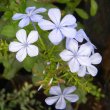
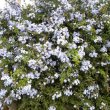
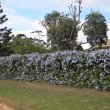

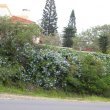
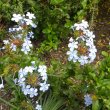


Comments
...perfect as a haven for birds
Escondido, California. Received as a gift in a 4 inch pot. After vigorous growth and achieving a height of 2 meters, the plant has a circumference of 8 meters, and is the home of at least 100 small birds, including a covey of 11 California Quail. This is a wonderful addition for viewing our feathered friends!
Plumbago in California
Hi Rodney
Thanks for your comment. I am delighted to hear that this plant grows so well there and amazed at how many birds are utilising it. As you say, a great plant for birds - the dense growth provides such a safe haven.
Kind regards
Lorraine
Discuss this plant
Share knowledge, ask a question or give an experience.